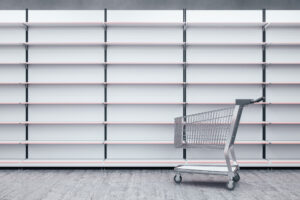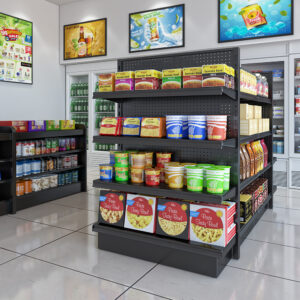 Did you know in-store sales are up by 13.7 percent compared to pre-pandemic levels? In fact, 20 percent of consumers state that they only shop in-store.
Did you know in-store sales are up by 13.7 percent compared to pre-pandemic levels? In fact, 20 percent of consumers state that they only shop in-store.
When your consumers walk in your door, what do they see? How do you get your share of the business returning to brick-and-mortar storefronts?
One simple thing you don’t want to forget about is retail shelving. There are some common retail shelving mistakes stores make that cost them money.
What are they? Keep reading and learn the mistakes and retail shelving tips that will help you showcase your merchandise.
Not Maintaining Your Shelves Well Enough
Have you ever gone into a store where the shelves or dusty? Or, even worse, you’ve found trash and half-eaten food on the shelf? That kind of thing is bound to happen when you run a store.
A customer picks up a sample; a few aisles later, they set the trash from that sample on the shelf and walk away.
However, no one wants to buy merchandise off a dirty shelf. This is true in every circumstance; however, it’s especially true if you sell food. It speaks a lot to your store and brand when you don’t properly maintain your shelves.
In addition, that goes beyond just cleaning your shelves. You also want to ensure that the shelves are in good repair.
Using Shelves That Place Merchandise Out of Reach
If your customer can’t reach the item they want to buy, will they track someone down to help them? Or, are they going to wait and hope someone taller wanders by and ask for help?
Or, are they going to try to climb the shelf to get what they need? There are a few things that can happen in this circumstance. First, they could choose not to ask for help and go without the purchase.
Or, if they try to climb the shelf to get the item they need, they could fall and get hurt. This puts your store at risk of a lawsuit.
The best solution to avoid these scenarios is to avoid placing merchandise in areas that are out of risk.
Poor Signage
Your signage matters just as much as your shelves. Your consumers need clear and understandable signage to help them find what they want and the prices.
Ensure that you use the proper signage for your shelves. In addition, make sure that your signage is easy to read and understandable.
Many customers like to comparison shop, and if your price tags are a mess, it makes it difficult. Customers don’t want to spend time looking for a price because it wasn’t easily accessible on the shelf.
When Your Shelving Doesn’t Match Your Brand
If you walk into a high-end retail shop and see metal shelves that look like they belong in a department store, it throws the entire aesthetic off. It doesn’t matter what type of retailer you are; your shelving should match your brand.
For example, if you’re an auto shop, black metal shelves are a great choice because they look like they would fit in an auto shop. If your shop has branded colors, you could also choose shelves that compliment those colors.
Random Mismatched Shelving
Not only should your shelving match your brand, but it should also match your other shelving. Randomly mismatched shelving sends a message to your customers.
They’ll believe that you don’t know your brand or that you don’t care. However, don’t completely eliminate the idea of using shelves that don’t always match. Sometimes one shelf in a well-placed position that contrasts with your other shelves can look great.
However, make sure to use that in moderation.
Remember the Layout of Your Shelves
The layout of your shelves is very important. You want everything to look organized, and while you want to optimize for space, you also don’t want to put too much on a shelf.
An overcrowded shelf can distract your customers and make it more challenging to find your desired product. In addition, you want to ensure that the placement of products isn’t chaotic.
Chaotic placement can make it challenging to shop and find what you want.
Consider Your Actual Products
How much variety do you have when it comes to your merchandise? Do you have a limited selection? In 2021, retail stores lost out on over 82 billion dollars because of empty shelves.
This was due to the pandemic, but it speaks to the fact that customers will go where they know they can find what they need.
Having a selection that’s too limited means, you won’t have the ability to meet the needs of your customers. If your customers consistently find that they can’t find what they need at your store, they won’t keep returning.
For example, if you run a clothing store but only stock a limited range of sizes, it’s likely you’ll miss out on customers who can’t wear the products you’re offering. Or, if you run a grocery store but don’t provide products that can meet the needs of varying diets, for example, gluten-free, you’ll lose and miss out on customers that may have shopped in your store.
It’s imperative that you consider your customers and their needs to ensure that you can meet those needs.
Too Many Shelving Accessories
If you put too many accessories on your shelf, it can become overwhelming to your customers. While you may want signs promoting different deals, too many are just as bad as too few.
Your customers want to know if you’re having a sale. However, too many accessories can make it complicated to keep track of what’s going on. Make sure you balance it well so that you don’t overwhelm your customers.
Reduce Retail Shelving Mistakes
Retail shelving mistakes can lead to your business losing out on money. Ensure you don’t make the retail shelving mistakes discussed above and maintain your shelves.
Do you need store signage or retail shelving for your retail store? Start shopping with Specialty Store Fixtures today and find the right solutions for your business.
